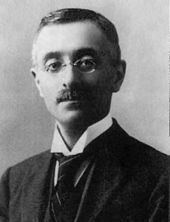Nationality Italian Role Mathematician | Name Tullio Levi-Civita | |
 | ||
Born 29 March 1873Padua, Italy ( 1873-03-29 ) Doctoral students Evan DaviesMendel HaimoviciOctav OnicescuAttilio PalatiniAntonio SignoriniLibera TrevisaniGheorghe Vranceanu Known for Tensor calculusLevi-Civita symbolLevi-Civita connectionLevi-Civita (crater)Levi-Civita field Died December 29, 1941, Rome, Italy Books The absolute differentia, Three Lectures on Mathe, The N‑Body Problem i | ||
Today in history professor tullio levi civita remembered 29 dec 2011
Tullio Levi-Civita, FRS (29 March 1873 – 29 December 1941; [ˈtullio ˈlɛːvi ˈtʃiːvita]) was an Italian mathematician, most famous for his work on absolute differential calculus (tensor calculus) and its applications to the theory of relativity, but who also made significant contributions in other areas. He was a pupil of Gregorio Ricci-Curbastro, the inventor of tensor calculus. His work included foundational papers in both pure and applied mathematics, celestial mechanics (notably on the three-body problem), analytic mechanics (the Levi-Civita separability conditions in the Hamilton–Jacobi equation) and hydrodynamics.
Contents
- Today in history professor tullio levi civita remembered 29 dec 2011
- Tullio levi civita
- Biography
- Other studies and honors
- Works
- Articles
- Books
- References
Tullio levi civita
Biography
Born into an Italian Jewish family in Padua, Levi-Civita was the son of Giacomo Levi-Civita, a lawyer and former senator. He graduated in 1892 from the University of Padua Faculty of Mathematics. In 1894 he earned a teaching diploma after which he was appointed to the Faculty of Science teacher's college in Pavia. In 1898 he was appointed to the Padua Chair of Rational Mechanics (left uncovered by death of Ernesto Padova) where he met and, in 1914, married Libera Trevisani, one of his pupils. He remained in his position at Padua until 1918, when he was appointed to the Chair of Higher Analysis at the University of Rome; in another two years he was appointed to the Chair of Mechanics there.
In 1900 he and Ricci-Curbastro published the theory of tensors in Méthodes de calcul différentiel absolu et leurs applications, which Albert Einstein used as a resource to master the tensor calculus, a critical tool in the development of the theory of general relativity. In 1917 he introduced the notion of parallel transport in Riemannian geometry, motivated by the will to simplify the computation of the curvature of a Riemannian manifold. Levi-Civita's series of papers on the problem of a static gravitational field were also discussed in his 1915–1917 correspondence with Einstein. The correspondence was initiated by Levi-Civita, as he found mathematical errors in Einstein's use of tensor calculus to explain the theory of relativity. Levi-Civita methodically kept all of Einstein's replies to him; and even though Einstein had not kept Levi-Civita's, the entire correspondence could be re-constructed from Levi-Civita's archive. It is evident from this that, after numerous letters, the two men had grown to respect each other. In one of the letters, regarding Levi-Civita's new work, Einstein wrote "I admire the elegance of your method of computation; it must be nice to ride through these fields upon the horse of true mathematics while the like of us have to make our way laboriously on foot". In 1933 Levi-Civita contributed to Paul Dirac's equations in quantum mechanics as well.
His textbook on tensor calculus, The Absolute Differential Calculus (originally a set of lecture notes in Italian co-authored with Ricci-Curbastro), remains one of the standard texts more than a century after its first publication, with several translations available.
In 1936, receiving an invitation from Einstein, Levi-Civita traveled to Princeton, United States and lived there with him for a year. But when the risk of war in Europe again rose, he returned to Italy. The 1938 race laws enacted by the Italian Fascist government deprived Levi-Civita of his professorship and of his membership of all scientific societies. Isolated from the scientific world, he died in his apartment in Rome in 1941.
Among his PhD students were Octav Onicescu, Attilio Palatini and Gheorghe Vrânceanu.
Later on, when asked what he liked best about Italy, Einstein said "spaghetti and Levi-Civita".
Other studies and honors
Analytical dynamics was another aspect of Levi-Civita's studies: many of his articles examine the three body problem. He wrote articles on hydrodynamics and on systems of differential equations. He is credited with improvements to the Cauchy–Kowalevski theorem, on which he wrote a book in 1931. In 1933, he contributed to work on the Dirac equation. He developed the Levi-Civita field, a system of numbers that includes infinitesimal quantities.
The Royal Society awarded him the Sylvester Medal in 1922 and elected him as a fellow in 1930. He became an honorary member of the London Mathematical Society, of the Royal Society of Edinburgh, and of the Edinburgh Mathematical Society, following his participation in their colloquium in 1930 at the University of St Andrews. He was also a member of the Accademia dei Lincei and the Pontifical Academy of Sciences.
Like Vito Volterra, being Jewish and anti-fascist, Levi-Civita was expelled from the Academy in his country as a consequence of the Italian Racial Laws.
Works
All his mathematical works, except for the monographs, the treatises and the textbooks are published in the six volumes of his "Collected works", in a revised typographical form, both amending typographical errors and author's oversights.
